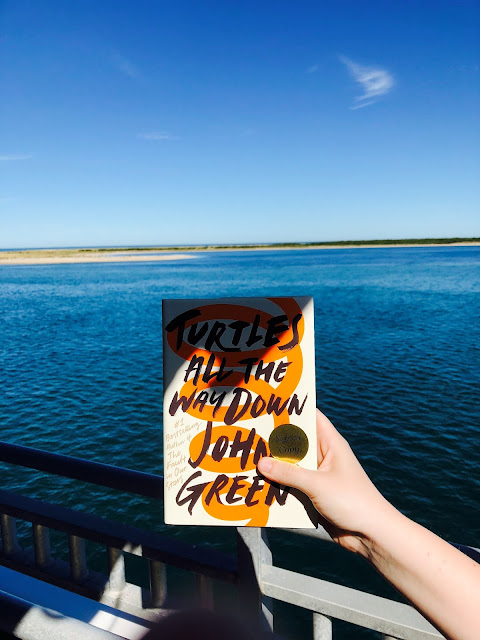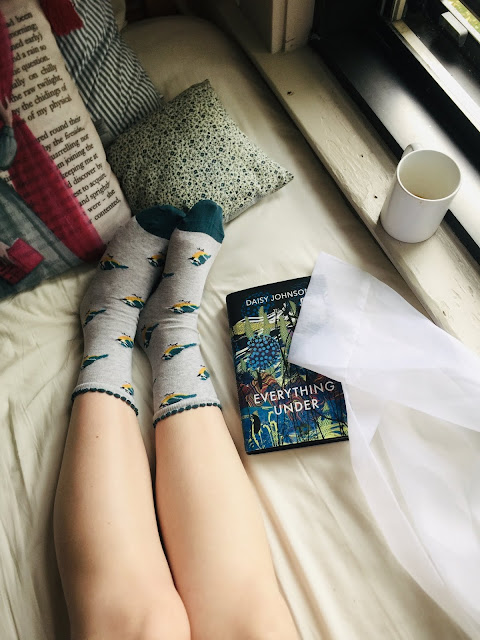Three Flakes, Then Four: John Green's Turtles All the Way Down
A version of this article was published in Counterpoint's October 2017 issue in print and online.
When I was fourteen years old, I bought The Fault in Our Stars at a Barnes and Noble in Darien, Illinois. It was a hot summer weekend, and I spent the afternoon in my grandmother's air-conditioned basement curled up on a blow-up mattress, falling in love with John Green's most recent novel of the time.
That night, once I finished the book, I turned to call my mother on the phone. When she didn't answer the first time, I tried to tell myself she was fine. She must have just fallen asleep. I waited ten minutes and called her again. She didn't answer. I called again, and again, and again. No answer.
I called my aunt, I called my house. No one knew where she was. I tried to calm down and convince myself that nothing could have happened, but I slowly dissolved into panicked tears. No matter how many times I told my mind that my mother was fine, I was utterly convinced she was dead.
She wasn't. Her phone had died at her boyfriend's house. She was fine. I, clearly, was not.
John Green has not released a book since I was fourteen years old. In that time, I have grown from a teenager with anxiety and OCD tendencies to a Wellesley student with a clearer understanding of her mental illness and a container filled with blue pills. Green, too, has changed, even if he remains the same author with underlying nerdy references, quotes from long-dead literary figures, and characters with quirks that are hilariously outrageous. I’d be lying if I said I didn’t love John Green or think him the greatest author of our generation at one point in my adolescent career. Green is successful because he gets teenagers; he puts himself back into their brains and immortalizes their realities, for better or worse.
That being said, Turtles All The Way Down is perhaps Green’s greatest work yet, purely because he doesn’t just illuminate the consciousness of a modern teenager. He gives a glimpse into his own mind—and his own mental illness.
Green’s protagonist, Aza Holmes, is sixteen and fears her life is fictional. She repeatedly reopens a wound on her finger, cleans it out, covers it in hand sanitizer, and puts a bandage on it, because she fears she will catch a terrible disease if she doesn’t, or the bacteria in her body will take over because her body really isn’t hers. She likes a boy, but she’s afraid to kiss him, or be close to him, or afraid that when he asks her what she’s thinking about, she’ll have to reveal what goes on inside her head. She spends time reading the same Wikipedia articles over and over, scavenging the Internet for statistics and possibilities about rare infections. She feels her thoughts have a mind of their own. She thinks that no matter how deep down she goes, she never has a self that is truly her.
Green’s Aza felt real to me in a way I’ve rarely seen in fiction. Daniel Handler’s Why We Broke Up came pretty close to an internal monologue that I could recognize in my sixteen-year-old self, and Penelope Lively’s Moon Tiger presents another, maturer consciousness that I deeply relate to. Green’s novel, though, verbalizes an everyday nightmare that individuals who suffer with chronic mental illness find as their unintelligible reality. Aza’s streams of inner dialogue between the rational and irrational are versions of arguments that I’ve repeatedly had in my head throughout the years, waiting for someone on the outside to validate my experience in a way that was neither apologetic nor condescending. Even Aza’s own relationship to literature mirrored the reflections I saw myself having with her story and other literature I love. In a particularly poignant scene, Aza quotes Edna St. Vincent Millay’s “Not So Far as the Forest,” which describes a snowfall. Aza compares her destructive thoughts to Millay’s observation of “Three flakes, then four / Arrive, then many more,” showing in practice the power of words to reveal inner truths.
Sure, Green’s novel still has some of his common tricks (and mistakes). His plot revolves around a missing billionaire, and said-missing-billionaire has a son who is, surprise, Aza’s love interest. He has many one-liners, some of which are clever, many of which are cheesy. Some of Green’s characters might be a bit too intellectually witty for teenagers. Still, they are a far cry from Hazel Grace and Augustus Waters, Green’s teenage protagonists in The Fault in Our Stars who are regularly criticized by readers for their cognitive superiority. Further, this time around, Green’s love story in many ways fails to be a love story. It is instead a friendship story, or, maybe even better, an understanding story. Green’s determination to reveal is what makes this work his strongest. His characters become more real even as they write fanfiction and create a new face from photographs of a hundred real ones; his protagonist portrays reality even as she worries over her own fictionality.
Good literature always hopes to reveal a truth of some sort. Whether or not that truth resonates with its readers as real determines that literature’s legitimacy. Green's Turtles All The Way Down was the truth I needed when I was fourteen and obsessively calling my mom on the phone, when I was fifteen and turned a boy down after saying yes because I panicked over my inability to conceptualize romance, when I was sixteen and couldn’t learn to drive because I was afraid to trust other drivers on the road, and when I was seventeen and convinced no one could ever want me because I was crazy. Through Turtles All The Way Down, John Green has given me the gift of a written consciousness, a novel I can hand to people and say, “See her? That’s me. That’s what it is sort of like to be in my head.”
Is Turtles my favorite book? Not even close. Is it perfect? No, certainly not. Neither are we, though. Neither am I. That’s what makes us real. That’s what keeps me trying.



Comments
Post a Comment